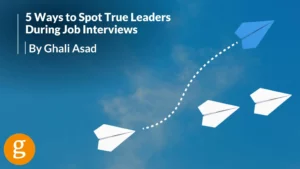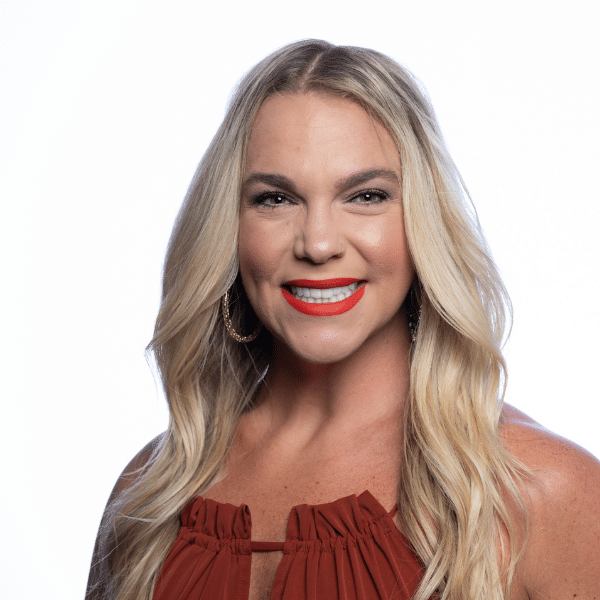5 Ways to Spot True Leaders During Job Interviews

Have you ever hired a candidate for a leadership position who sounded perfect and presented well during the job interview process – but once they started, everything went sideways?
They had the right answers. The right experience. The right confidence.
And yet…
- The team started struggling.
- Decisions took forever.
- Problems just sat there, collecting dust.
Unfortunately, it happens. A polished interview doesn’t mean you found the right hire. Great interviewers aren’t always great leaders. Executives and other senior-level candidates know how to sell themselves. They’ve been in the game long enough to master the art of sounding impressive.
Given what’s at stake for your organization, a candidate must be able to demonstrate their value through how they think, act, lead, and reveal their leadership qualities – not just in what they say to you. If you’re hiring an executive or senior-level professional for your team, be sure to go beyond a polite Q&A session about their past jobs and put their leadership acumen to the test.
Here’s how to find out if a candidate is truly the right hire for your critical leadership role.
Instead of focusing on the candidate’s past, uncover how they think right now
Management teams and hiring managers routinely rely on posing the same types of interview questions, such as, “Tell me about a time when (insert a situation or challenge).” Most candidates have a plethora of shining examples at the ready for questions like these. And sure, experience is important. But someone who aced a situation at one company won’t necessarily succeed at yours.
Here’s why:
- Every company is different. What worked for the candidate in their last role may not work for your organization and unique culture.
- Leadership isn’t just about experience. It’s about problem-solving, decision-making, conflict resolution, and adaptability.
- You’re hiring for the future, not the past. You need to know how they’ll handle today’s challenges.
Here are five ways to move your interview criteria from good to great in identifying true and agile leaders.
1. Ask better, more revealing questions
Rather than ask candidates to reminisce about the good old days, prompt them to think in real time.
Here are some example questions:
“If you started this job today, what’s the first thing you would do?”
→ This question forces the candidate to think and speak strategically, not just retell old war stories.
“If you had to increase revenue by 20% in the next year, how would you approach it?”
→ A real leader won’t throw out vague corporate buzzwords or generalities. Instead, they’ll start by asking you smart questions, consider the specifics, and lay out a viable plan for you.
“How would you handle stepping into a team environment with low morale and high turnover?”
→ This question tests the candidate’s people skills, emotional intelligence, and leadership instincts and traits.
Red flags: They avoid specifics and give canned, generic answers.
Green flags: They get curious, ask you smart follow-up questions, and show you that they think through different factors and angles before responding.
2. Observe how they handle being wrong
Effective leaders aren’t perfect (and they know it). They screw up, just like the rest of us. The difference? Great leaders own their mistakes, learn, and move forward. Weak leaders get defensive, blame others, or act like mistakes never happened.
If someone lacks the humility to admit when they’re wrong, they’re going to be a nightmare for your team and organization to work with.
Here are example questions to help you assess a candidate’s leadership style and effectiveness:
“Tell me about a mistake you made. What happened next?”
→ Are they honest about what went wrong? Or do they just tell a “mistake” story that avoids accountability or conveniently makes them look like a hero?
“What’s a decision you made that backfired? How did you handle it and adjust?”
→ Answers to this question reveal if a candidate can pivot and learn, rather than double down on bad choices.
“Have you ever changed your mind about something big? What made you rethink it?”
→ This question tests intellectual adaptability. A candidate’s answers will tell you if they are open to new ideas, perspectives, and learning.
Red flags: They struggle to admit mistakes or try to make every failure sound like a genius move.
Green flags: They’re self-aware, open, and show real strength and ability to evolve and grow.
3. Find out if they think like an owner
Here’s the difference between a good executive and a great one: A good leader does their job. A great leader thinks like they own the place. You don’t just want someone who will execute tasks and manage people. You need someone who will challenge the status quo, drive growth, and make tough calls.
Questions like these will help you uncover these distinctions:
“If this were your company, what’s one thing you would change if you discovered a prevalent issue?”
→ This question tests how they would manage inefficiencies, challenge norms, and take initiative.
“If you had to cut costs by 15% without hurting performance, where would you start?”
→ Answers to this question will reveal if they can think strategically and make hard financial decisions.
“Let’s say a competitor launches something that threatens our business. What would you do?”
→ Answers will inform you if the candidate understands competitive strategy, market shifts, and innovation.
Red flags: They give shallow or safe answers that don’t really challenge anything.
Green flags: They talk about eliminating competitive blind spots and finding opportunities, and they express the need to shake things up by escalating innovative thinking among teams.
4. Look beyond confidence: Check for humility
Confidence is great. But confidence without humility shows a lack of leadership skills, or worse, just arrogance. Truly great leaders don’t act like the smartest people in the room. They’re the ones who listen, learn, and create more leaders. If they’re not open to feedback, they’re going to stifle productivity, team morale, and company success.
Here are some ways to learn if a candidate possesses or falls short of the humility factor:
“What’s a piece of feedback that changed how you lead?”
→ This question separates those who genuinely grow from those who think they already know everything.
“What’s something you once believed about leadership that you no longer do?”
→ Answers to this question will show self-awareness, critical thinking, and the knowledge that the best leaders never stop learning and growing.
“Tell me about a time when you were wrong about an employee.”
→ Effective leaders are big on communications with team members and quick to adjust their thinking when they find their observations lack grounding or their perspective is short-sighted.
Red flags: They struggle to name a single time they’ve been wrong.
Green flags: They learn through their communication skills and interactions with team members, listen to others, and adapt their thinking with agility.
5. Observe during interviews, rather than just listen
A strong interview isn’t just about answers. It’s about how the candidate engages. Great leaders bring curiosity and presence into the room. They don’t just try to impress. They try to understand through genuine engagement with you.
Pay attention to these forms of engagement by the candidate:
✔ Do they ask smart questions or just talk about themselves?
✔ Do they listen carefully or just wait for their turn to speak?
✔ Do they take time to think before answering or quickly respond with whatever sounds good?
Red flags: They dominate the conversation without asking about your company and its goals, your company values, your company culture, your teams, and specifics of the role.
Green flags: They listen, reflect, and ask insightful follow-up questions.
Elevate your search for top-tier talent
Impressive resumes and confident interview answers don’t build great companies. Real leaders do, and their mettle is revealed in how they think on their feet, interact, solve problems, and drive results. So, the next time you’re interviewing a high-level candidate during your hiring process, look and probe beyond their credentials:
- Push them to think.
- See how they will lead – today.
- Find out how they push others forward, identify leadership potential, and develop new leaders.
Contact me for assistance in finding the right leadership candidates for your organization. My name is Ghali Asad and I am a senior recruiting partner with Goodwin Recruiting, a Forbes Best Recruitment Company. I’ve spent the past 20 years helping businesses build high-performing teams by securing top-tier executives and senior-level professionals. I welcome the opportunity to help streamline your search.
Share This Article






































